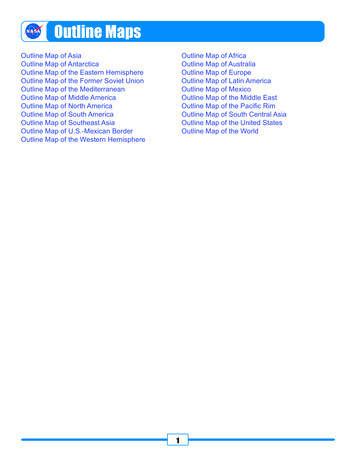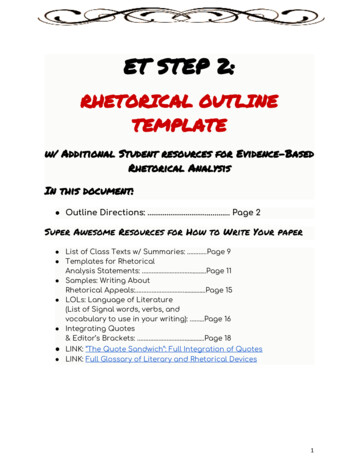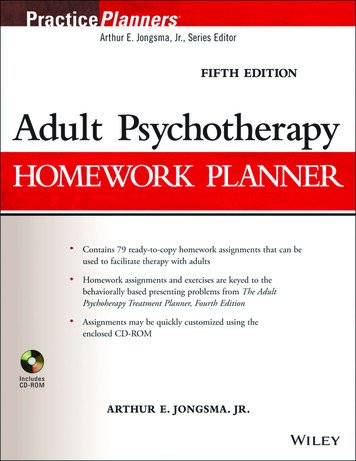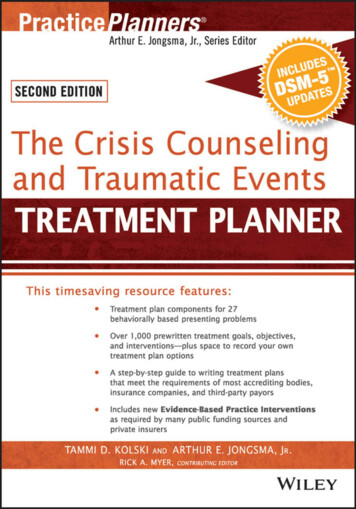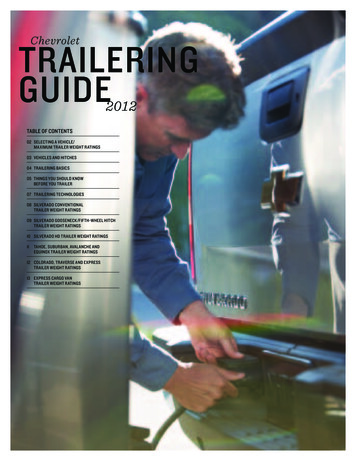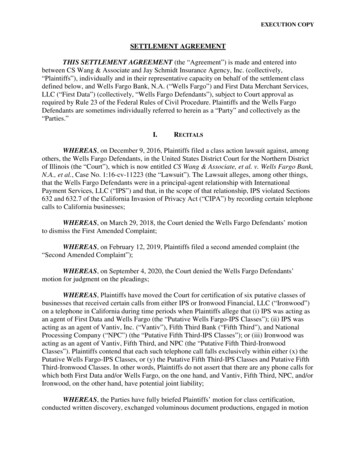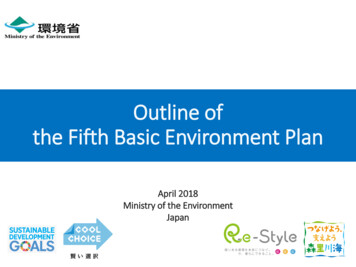
Transcription
Outline ofthe Fifth Basic Environment PlanApril 2018Ministry of the EnvironmentJapan
Overall Structure of the Fifth Basic Environment PlanWhat is the Basic Environment Plan?・Plan stipulates outline of comprehensive long-term measures on environmental conservation based on Article 15 of the Basic Environment Act・Plan is revised approximately every 6 years (Fourth Plan decided by the Cabinet in April 2012)・Following consultation by the Minister of the Environment in February 2017 on the revision of the Plan, Central Environment Council discussed andreported its findings on 9 April 2018・Based on the findings, the Cabinet decided the Fifth Basic Environment Plan on 17 April 2018Part 1 Environmental, Economic and Social Conditions and Direction of Development of Environmental Policies Current state and recognition of challenges (Challenges facing Japan inseparably linked and ever-more complex. International trends include SDGs and ParisAgreement) Basic concepts for the development of future environmental policies (innovation creation, simultaneous solutions for economic and social challenges)Part 2 Putting the Environmental Policy into Action1. Set up six interdisciplinary cross-cutting “priority strategies” (economic, national land, community, life, technologies, international)*To develop priority strategies, focus on partnerships (links with all stakeholders)*Aiming to build a self-reliant and decentralized society in each region, creating a “Circulating and Ecological Economy” to complement and supportregional resources2. Steadily advance initiatives on environmental conservation including environmental risk management as “environmental policies to support prioritystrategies”Part 3 Effective Implementation of the Basic Environment Plan Describe promotion of measures by government and other entities, review of the Plan and utilization of indicators, and revision of the PlanMainly conduct interviews on good practices for “priority strategies” reviewPart 4 System of Environmental Conservation Measures Describe system of environmental conservation measures1
Environmental, Economic and Social Challenges Facing JapanEnvironmental Challenges Changes in average ground temperature change distribution(from Annual Report on the Environment 2017) Drastic reduction in GHG emissionsEffective use of resourcesDestruction of forests and SatochiSatoyama (socio-ecological productionlandscapes), damage by unmanagedwildlifeConservation of biodiversity etc.Inseparably linked,ever-more complexChanges in rates of vacant stores in shopping districts(from Small and Medium Enterprise Agency website)Economic Challenges Damage by Sika deer (from MOEJ website)Battered regional economiesGlobal competition with emergingcountriesResponse to technological innovationincluding AI and IoT etc.Long-term population trends in Japan(from Ministry of Land, Infrastructure, Transport and Tourism website)Social Challenges Decreasing birthrate and aging demographics /overall population declineWorkstyle reformPreparations for large-scale disasters etc.Integrated Improvements on Environment,Economy and Society (II2ES) !Image of AI (from National Institute of AdvancedIndustrial Science and Technology website)Heavy rain in northern Kyushu, July 2017 (from Ministry of Land,Infrastructure, Transport and Tourism website)
International Trends for Sustainable Society ※ September 2015: Adoption of the “2030 Agenda for Sustainable Development”Including SDGs addressing multiple issues in an integrated mannerDecember 2015: Adoption of the “Paris Agreement”※ To keep average temperature rise below 2 degrees, aims to reduce greenhouse gas emissionsto practically zero in the second half of this centuryAdoption of the Paris Agreement17 goals of SDGsTurningpoint(Reference materials: United Nations Information Centre)Prime Minister Abe making a speech at summit meeting of world leaders at COP21where the Paris Agreement was adopted(from Prime Minister of Japan and His Cabinet website)Time to start moving towards a new civilized society,with a major shift in our basic thinking (paradigm shift)3
Basic Direction of the Fifth Basic Environment PlanMountainous,agricultural andfishing villagesWhat Does a Future Society Look Like?1. Creation of a “Circulating and EcologicalEconomy”2. Establishment of “Japan as a global exemplarymodel” ※ Possible because of1) experience with pollution, 2) excellentenvironmental technologies, 3) spirit of circulation“Mottainai” and tradition of living in harmonywith nature3. Building a sustainable, circulation andsymbiosis based society “Environmental andLife Centered Civilized Society”Basic ApproachForests Natural resources/Ecosystem servicesself-reliant and decentralized society(circulation of regional resources [natural,material, human, financial])・food, water, timber・natural energy・water purification, prevention ofnatural disasterslocal production for local consumption,introduction of renewable energyCitiesCountrysideself-reliant and decentralized society(circulation of regional resources [natural,material, human, financial])local production for local consumption,introduction of renewable energyRivers Provision of funds and human resourcesSea・participation in nature conservation activitiessuch as ecotourism・consumption of local products・support through socio-economic systems・investment in local fundsCirculating and Ecological Economy Each region demonstrates its strengths by utilizing its unique characteristics Makes use of regional resources and builds a self-reliant anddecentralized society Complements and supports one another according to uniquecharacteristics of each region1. Utilizing the concepts of SDGs, realizing the Integrated Improvements on Environment, Economy andSociety (II2ES) Taking environmental policies as opportunities, create innovations across all perspectives Simultaneous solutions for economic, regional and international challenges “New avenues for growth” that ensure quality of life is maintained into the future2. Maximize the sustainable use of regional resources for improvements in economic and social activities Focus on maintenance and development of regions Providing vitality to regions through variousenvironmental measures !3. Partnerships with a wide range of stakeholders Enriching and strengthening partnerships with a wide range of stakeholders4
Development of Measures in the Fifth Basic Environment Plan Set up six interdisciplinary cross-cutting priority strategies Realizing the Integrated Improvements on Environment, Economy and Society (II2ES) under partnerships Creating innovations across all perspectives including those concerning socio-economic systems, lifestyles, andtechnologiesSix Priority Strategies1. Formulation of a Green Economic System for RealizingSustainable Production and Consumption2. Improvement of Value of National Land as Stock Promotion and expansion of ESG investment and green bond etc. Promotion of greening of the whole tax system Servicizing and sharing economy Hydrogen production from renewable energy,Offshore wind power generation facilityhydrogen supply chain(from Annual Report on the Environment 2016) Utilization of urban mining etc. Resilient society including climate change adaptation Eco-DRR Maintenance and conservation of forests including utilization offorest environmental tax Compact cities, small hubs renewable energy/energy saving Forest reserve for landslide Measures to deal with marine litter including microplastics etc.prevention3. Sustainable Community Development Using Local Resources “Human development” Expansion of green finance in local areas Improve balance making use of resources and energy Local revitalization centering on national parks Conservation, regeneration and use of forests,the countryside, rivers and the sea with cities involved Symbiosis and exchange among mountainous,agricultural and fishing villages, and cities etc.Biomass power generation(from Annual Report on theEnvironment 2017)5. Development and Dissemination of TechnologiesSupporting Sustainability Fukushima Innovation Coast concept driving towardsdecarbonization (hydrogen production from renewableenergy and floating offshore wind power etc.) “Logistics revolution” using unmanned autos and drones Production of chemical products from biomass(cellulose nanofiber etc.) Optimization of production using AI etc. etc.(from MOEJ website)4. Realization of a Healthy and Prosperous Life Switching to a sustainable consumption behavior(ethical consumption, COOL CHOICE etc.) Reduction of food waste, appropriate treatment of waste Dissemination of low carbon and healthy housing Workstyle reform by teleworking reduceCO2 and resources Promotion of rural migration and dual-residence lifestyle management of forests, the countryside, rivers and the sea Conservation of a good living environment etc.Connecting forests, thecountryside, rivers, andthe sea (from MOEJwebsite)6. Demonstration of Japan's Leadership throughInternational Contributions and Building Strategic PartnershipsCellulose nanofiber (fromAnnual Report on theEnvironment 2017) Exporting environmental infrastructure Adaptation support through Adaptation Platform Greenhouse gas observation satellite "IBUKI" (GOSAT)series Support for building “sustainable societies” in otherMinister for the Environmentattending COP to the Minamatacountries as an “advanced nation to solve modernConvention on Mercury First meetingchallenges” etc.5
Environmental Policies to Support Priority StrategiesSteadily advance initiatives on environmental conservation as the roots and trunk of environmental policy Climate Change MeasuresBased on the Paris Agreement, implement measures listed in the Plan for Global Warming Countermeasures, promot ion oflow carbonization of electric power sector including thermal power generation (coal-fired power etc.) for long-term drasticreductions, implement measures listed in the National Plan for Adaptation to the Impacts of Climate ChangeCollection of CFC(from MOEJ website) Establishment of Sound Material-Cycle SocietyImplement measures listed in the Fundamental Plan for Establishinga Sound Material-cycle SocietyWaste separationprocess (from MOEJwebsite) Securing Biodiversity and Living in Harmony with NatureImplement measures listed in the National Biodiversity Strategy ofJapan 2012-2020Endangered species(Itasenpara bitterling) Environmental Risk ManagementEnvironmental conservation of water, air and soil, chemical substancemanagement, environmental health measuresWater environmentconservation (fromMOEJ website) Various Basic MeasuresEnvironmental Impact Assessment (EIA), environmental research & technologydevelopment, environmental education & learning, environmental information etc.Environmentaleducation (fromMOEJ website) Reconstruction After the Great East Japan Earthquake/Responses to Future Large-scale DisastersConstruction of Interim Storage Facility (ISF), development of specified reconstruction and revitalization bases in Areas whereReturning is Difficult (ARD), health management and response to health concerns of residents regarding radiation exposure,reconstruction of disaster-hit areas through resource circulation, disaster waste treatment, environmental conservationmeasures in disaster-hit areas etc.Interim storage facilities, soilstorage facilities6
(Reference Material)Outline of Priority Strategies
Priority Strategy 1:Formulation of a Green Economic System for Realizing Sustainable Production and Consumption To ensure sustainable production and consumption patterns, this Plan will aim for socio-economicsystem innovation, as well as improved resource productivity and carbon productivity Renewable energy and energy conservation are major pillars of measures against global warming andcontribute to better energy security and strengthen industrial competitiveness Greening of the economic system using finance and tax systemFuel cell vehicle and hydrogen station(from Kyushu University website)1. Expansion of Environmental Business and Mainstreamingof Environmental Considerations in Corporate Strategy Expansion of environmental business・Gain better understanding of the market size of environmental business, developbest operating practices Promotion of environmental management throughout the value chain・Formulation of mid and long-term reduction targets for individual companies,promotion of efforts to calculate and reduce value chain emissions, introduction andpromotion of environmental management system Servicizing and sharing economy・Visualization of contributions to low carbonization andresource saving of new business models Green procurement / Green contract Promotion of exporting green products/services/environmental infrastructureCycle port(from MOEJ website)・Utilize bilateral policy dialogues, regional forums etc.2. Improvement of the Balance of Payments andStrengthening of the Industrial Competitiveness throughMaximum Use of Domestic Resources Promotion of all-out efforts for energy conservation・Local governments action plans based on the Act on Promotion of Global WarmingCountermeasures, Energy Conservation Act Maximum introduction of renewable energy・Wider operation of the grid system, introducing a self-reliant and decentralizedrenewable energy Expansion of the use of hydrogen・Technological development and dissemination of stationary fuel cells, fuel cellvehicles, technological development and demonstration of low-carbon hydrogen Utilization of biomass・Expansion of power generation and heat utilization by using woody biomass andbiogas Utilization of circular resources, urban mining・Promotion of recycling of small household appliances3. Formulation of a Green Economic System through Finance4. Tax System as the Basis of Green Economic System Promotion and expansion of ESG investment・Maintain and improve platform to boost active dialogue between investors andcompanies based on environmental information etc. Promotion of investment and loans to green projects・Support low carbon projects, support green bond issuance and subsequentinvestment Promotion of greening of the whole tax systemWind power generation (from MOEJ website)8
Priority Strategy 2: Improvement of Value of National Land as Stock Develop national land responding to economic and social challenges with environmental considerations incorporated Create sustainable and attractive cities through compact cities and appropriate maintenance and effective utilization ofstock Improve resilience using environmental and green infrastructure including strengthening capacity to prevent and reducedisasters utilizing diversified functions held by the natural environment1. Maintenance of the Diversity of the National LandCentered on Living in Harmony with Nature Maintain, enhance and utilize natural capital・Promoting sustainable use of natural capital as stock, promotionof national land use responding to economic and social challengeswith environmental considerations incorporated Maintenance and conservation of forests including utilization offorest environmental tax・Diversified and healthy forests Establishment of ecosystem networks Conservation of marine environment such as measures to dealwith marine litter Maintenance and restoration of soundwater circulation Appropriate land managementresponding to a declining population andnational land use that conserves,regenerates, and utilizes the natural environmentConservation and regeneration of Measures against invasive alien speciesSatochi-Satoyama2. Creation of Sustainable and Attractive Cities and Communities Realization of compact urban space with neighborhood nature・Formation of compact cities Formation of “Small hubs”・Maintain a “community living area”, support introduction ofrenewable energy utilizing local resources Maintenance and utilization of traffic networks・Collaboration among multiple publictransportation companies, encourage bicycle useToyama Light Rail Appropriate maintenance and effective utilization(from MOEJ website)of the existing infrastructure stock・Improving value of stocks of existing infrastructure by ensuringprolonged use, improved disaster prevention function, and promotionof energy efficiencies3. Improvement of Resilience by Use of Environmental andGreen Infrastructure Promotion of green infrastructure and Eco-DRR・Ecosystem-based Disaster Risk Reduction(Eco-DRR) Promotion of climate change adaptationmeasures Securing consistent safety in usual times and in times of accident/disaster・Promotion of adaptation measures in・Strengthening the waste treatment system, promotion of coherent initiatives agriculture and disaster prevention etc.to strengthen resilience of national land and reduce carbon emissionsFlood mitigation through regeneration of wetlands (from MOEJ website)9
Priority Strategy 3:Sustainable Community Development Using Local Resources Improve the quality of local resources and maximize utilization of the natural capital, the artificial capital and the humancapital of the area in a sustainable way Contribute to developing major parts of Regional CES through utilizing circular resources and renewable resources1. Maximizing Utilization of Local Energy and Biomass Resources Introduction of renewable energy utilizing local resources・Improve local energy balance, improve local resilience in times ofdisaster Promotion of new local power producers and suppliers Promotion of farming photovoltaics (FPV) Community development with un-utilized biomass resources・Use of woody biomass resources as self-reliant and decentralizedenergy Resource circulation includingutilization of waste biomass in local areas・Local circular resources andrenewable resources circulated andutilized through reuse and recyclingSolar sharing (from MOEJ website)2. Maximizing Utilization of Local Natural Resources andTourism Resources Local revitalization centering on national parks etc.・Branded as world-class “National Parks”, create a virtuous cycle ofrevitalization of the local economy and nature conservation Promotion of tourism including ecotourism・Promotion of creation of a sustainable community bytaking full advantage of the local-specific natural resources,promotion of green and blue tourisms Utilization of diverse cultural resources from nature・Using and passing on local features rooted in the natureAkan-MashuNational Parkof each area and diverse histories and cultures unique to the area(from MOEJ Improvement of added value of local industrieswebsite)focusing on environmental conservation andsustainability・Promotion of sextiary industries by utilizing natural capital Drastic measures to strengthen capture of designated wildlife species formanagement・Recruitment and education of hunters, promotion of control measures inaccordance with target wildlife3. Symbiosis and Exchange among Mountainous, Agricultural and Fishing Villages, and Cities, andCreation of a Wide-area Network Efforts to connect and support forests, the countryside, rivers and the sea・Sustainable use of local resources from forests, the countryside, rivers andthe sea Symbiosis and exchange among mountainous, agricultural and fishingvillages, and cities・Symbiosis through mutual contribution of mountainous, agriculturaland fishing villages, and cities Community development through human development・Promote human resource development aimed at creatingsustainable communities that feature cooperation with diversestakeholders Expansion of green finance in local areas・Promote understanding of green finance among local financialinstitutions4Projects to experiencenature (from MOEJwebsite)10
Priority Strategy 4: Realization of a Healthy and Prosperous Life Create lifestyle innovation and shift to environmentally friendly, healthy and high quality lifestyles and workstyles Recognize the values of nature including forests, the countryside, rivers and the sea and reconstruct the connectionbetween people and nature, and within communities Assess environmental risk which threatens to people’s health and prosperous lives, and promote precautionaryapproaches1. Switching to Environmentally Friendly, Healthy and HighQuality Living Switching to a sustainable lifestyle and consumption・Promotion of consumption behavior considering people, society andenvironment etc. Reduction of food waste・Setting a target for reduction of food waste,measuring the amount of food waste etc. Low carbon and healthy housing・Promote well-insulated and airtight housingincluding ZEH for seniors etc.Zero energy housing Extension of healthy life expectancy by walking,(from MOEJ website)riding bicycle, etc.・Contribute to reduce greenhouse gas emissions, benefithealth and ease traffic congestion etc. Promotion of a workstyle reform by teleworking・Reduce transport-related CO2 emissions and see a decrease in paperconsumption, “visualization” of environmental effects etc.2. Transformation of Lifestyles More in Contact withForests, the Countryside, Rivers and the Sea Promotion to experience nature and lifestyles of mountainous,agricultural and fishing villages・Build a social system to experience nature etc. Promotion of rural migration and dual-residence lifestyle that contributeto sound management of forests, the countryside, rivers and the sea・Unified information sharing and consultation for rural migration anddual-residence/dual-activity lifestyles etc. Creation of new timber demand and educatingconsumers・Expansion of using wood such as CLT, promote“Ki-Zukai (wood-using) movement” and“Wood Education” etc.Ceremony for appointment of Nature Ambassadors(from MOEJ website)3. Conservation of a Good Living Environment as a Basis for Safe and Secure Life Comprehensive management throughout the entire life cycle of Maintenance and restoration of healthy and rich water environmentchemical substances・Evaluate, maintain and restore habitats for living creatures etc.・Promote proper use of chemical substances etc. Comprehensive domestic and international measures Promotion of measures against marine litter including microplastics Promotion of appropriate treatment of waste・Waste treatment facilities to be enhanced, concentrated to serve wider areas, ・Promote studies to gain accurate information, measures for collection &treatment and preventing generation, and international cooperation etc.utilized intensively over much longer periods, business operators taking full Measures against heat island effectresponsibility for waste they generate, response to aging society etc.11
Priority Strategy 5: Development and Dissemination ofTechnologies Supporting Sustainability Promote development and dissemination of environmental technologies to contribute to addressing challenges facing Japan Aim to realize the Society 5.0 using ICTs such as AI Contribute to improving global environmental problems by superior environmental technologies, as an advanced nation to solvemodern challenges1. Development of State-of-the-art Technology Supporting the2. Development of Technologies Applying Natural Laws andRealization of a Sustainable SocietyMechanisms Ensuring efficient use of energy and secure a stable supply of energy・Energy conservation technologies (GaN device etc.)・Improving efficiency and lowering cost of renewable energy・Fukushima Innovation Coast concept, driving towards decarbonization(hydrogen production from renewable energy and floating offshore windpower) Responding to climate change・Technologies that will contribute to drastic reduction of globalgreenhouse gas emissions, such as CCUS (Carbon dioxide Capture,Utilization and Storage) Securing stable supply of resources and circular utilization・Resource efficient technologies, technologies to produce safersubstitute materials Utilization of ICTs such as AI, IoT・Optimization of production using AI etc. "Logistics Revolution" by utilizing new technologies・Promote low carbon logistics using unmanned autos and dronesGaN device to drasticallyreduce energy consumption(from MOEJ website)Facility to captureCO2 emissions frompower plant (fromMOEJ website) Production of high-value-added chemical products from biomass・ Biomass-derived chemical products such as cellulose nanofibers andbiomass plastics etc. Boosting innovative biotechnology・Maximize application of potential biological functions through integrationwith ICTs Utilization of technology closer to natural laws and mechanisms・Low impact environmental technologies utilizing biomimetics etc. Conservation and restoration of biodiversity・Technologies for sustainable management and utilization of ecosystemservices Ecosystem-based disaster risk reduction (Eco-DRR)・Establishment of construction methods, maintenance and managementmethods, and evaluation of relevant ecosystem functionsTide prevention forest(Ishigaki-shi, Okinawa)(from MOEJ website)3. Promotion of Early Social Implementation of Technology Acceleration of dissemination and development through standardization and streamlined regulations・To institutionalize technologies, and accelerate dissemination and development, cross-governmental integrative approach is needed to promotestandardization and streamlining of regulations Support for technical evaluation / demonstration12
Priority Strategy 6: Demonstration of Japan's Leadership throughInternational Contributions and Building Strategic Partnerships Active involvement and contributions to international rule-making and support to build a sustainable society indeveloping countries Present to the world the model advocated by the Circulating and Ecological Economy in Japan as a package andcontribute to the formation of a sustainable region1. Active Involvement and Contributions to International Rule-making Active involvement in discussions of international rule-making・Active participation in international negotiations・Aim to formulate rules that can make use of our strengths, andcontribute to international consensus building Enhancement and active provision of scientific knowledge as abasis for international rules・Input and support to IPCC and IPBES, enhancement and activeprovision of scientific knowledge・Contribute to the advancement of international research onclimate change through continuous global observation byGreenhouse gases Observing Satellite "IBUKI" (GOSAT) series2. Support for Building Sustainable Societies in Other Countries Dissemination of excellent environmental infrastructureoverseas・Facilitate dissemination of environmental infrastructure throughthe JCM etc.JCM joint committee(from MOEJ website) Support for climate change mitigation in developing countries・Developing infrastructure by creating a package ofcomplimentary systems among institutions, technologies andfunds Adaptation support in developing countries, internationaldevelopment of good practices in Japan・Promote the "Satoyama Initiative"Launch of “InternationalPartnership for the SatoyamaInitiative” (from MOEJ website)Greenhouse gas observation satellite GOSAT-2 (from JAXA website) Institution building, capacity development support, andawareness raising in developing countries・Create innovations in collaboration with developing countries13
Current state and recognition of challenges (Challenges facing Japan inseparably linked and ever-more complex. International trends include SDGs and Paris Agreement) Basic concepts for the development of future environmental policies (innovation creation, simultaneous solutions for economic and social challenges) Overall Structure of the Fifth Basic Environment Plan


